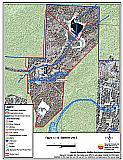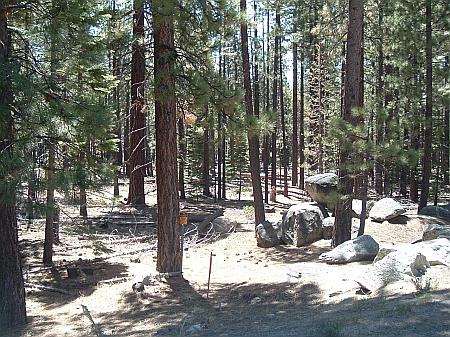Risk/Hazard Identification and Mitigation Project Worksheet
Name of Community: Stateline
Date: July, 2004
Project Title: Stateline Unit 3 - Thinning and Brush Removal
Description of Risk/Hazard: Describe in detail the risk or hazard that poses a threat to the community.
Vegetative Fuel and Topography: The Stateline Unit 3 prescription area is characterized by a forest stand of Jeffrey pine with some white fir, incense cedar, and sugar pine that was thinned twenty years ago. There is a brush understory and open brush fields dominated by bitterbrush, manzanita and tobacco brush. The majority of the project site is on slopes less than 30%. Increased mortality due to drought and insects has increased the volume of dead and down woody material.
Worst Case Scenario / Hazard: A wind driven fire ignited at the bottom of the treatment area would spread uncontrollably uphill, threatening the sewer treatment facilities, the school, and residential areas around Chimney Rock.
Priority Ranking: What is the priority ranking of this risk/hazard in relation to all others identified?
This project is ranked as #7 because of heavy fuels.
Location: Describe or attach a map with sufficient detail to allow accurate ground location.
Site surrounds the sewage treatment plant, a Sierra Pacific Power transformer site and the Kingsbury Middle School. See Figure 11-16 for details
Recommended Mitigation Measures and Scope of Work: Present prescription and work specifications in sufficient detail to facilitate procurement of bids and quotes. For hazardous fuel removal projects include estimated volumes (tons/acre) of fuel removed and disposal plan.
The entire prescription area needs to be thinned to reduce fuel loadings and increase forest health. Thin from below, removing smaller trees and leaving larger ones to achieve the desired stocking rate of 80 to 100 square feet of basal area per acre. Parts of the prescription area are relatively flat where mechanized treatment methods may be used. Areas with steep slopes require that work be completed by hand or aerial systems. A cable yarder could be effective in treating part of this area, however, cable systems are listed as a ground based system by TRPA. Remove or burn slash from the thinning operation. The objective is to thin the stand to open the tree canopy, and allow the heat of a ground fire to vent through the crowns, lowering fire intensity and preventing a crown fire. Consider whole tree skidding on slopes 30% or less.
*Prescribed fire could be used to maintain the effects of the previous treatment, and desired where feasible to return fire to the landscape. It should only be applied in areas after thinning and slash pile burning are complete to maintain fire control.
Evaluation of the Extent to Which Completion of This Project Will Reduce the Fire Threat:
Treatment in this area will help contain human-caused ignitions below the project area, keeping fire from spreading uphill and becoming uncontrollable. Critical municipal infrastructure, such as the electrical substation and sewage treatment plant will be protected. Implementation of the prescription will reduce the competition among residual trees, increasing forest health and decreasing tree mortality. This will reduce the amount of accumulated dead and down material contributing to the fuel loadings on the forest floor. Thinning will also increase the spacing between residual trees, allowing heat from a ground fire to escape through the canopy, lowering fire intensity and decreasing the ability of the stand to carry a crown fire.
If all of the recommendations in this report are implemented, there is still no guarantee that a devastating wildfire will not occur in the area. However, community awareness and individual attention to fuels management on private property and fuel reduction on state, federal, and county property will help to achieve the highest level of wildfire safety possible.
Identification of Protected Species or Other Critical Resources: Describe any measures that must be taken to protect critical wildlife habitat, historic
Environmental compliance measures must be implemented before project initiation. Stream Environment Zones are located in the project area and must be protected, employing appropriate TRPA mitigation measures.
Some threatened and endangered species exist in the Tahoe Basin. Appropriate avoidance and mitigation measures should be employed during project implementation.
Compliance with cultural resource protection may also be necessary. Check with TRPA and the NVSHPO to ensure cultural resources are protected.
Post-project Rehabilitation: Present scope of work in sufficient detail to facilitate procurement of bids and quotes.
Rehabilitate any fire control lines, landings or disturbed areas. Rehabilitation will be minimal if only handmethods are used. Where soil has been disturbed, TRPA rehabilitation measures and Best ManagementPractices would apply. This could include reseeding or mulching areas if necessary.
Estimated Timeline:
Desirable time of year to complete:
May - December
Estimated time required to complete project:
One operational season with ground based equipment.
Estimated Cost: Present an estimate of the total cost of project completion and the basis for the estimate presented. If the project can be subdivided into phases or various components, present an estimated cost for each.
| Mechanical Treatment (Slopes <30%) | $1,750.00/ AC. for 66 acres |
| Hand cut, pile, and burn (Slopes >30%): | $2,000 / acre for 56 acres |
| Prescribed fire: | $2,000 / acre for 122 acres |
| Total Cost | $471,500 |
Biomass to be removed is approximately 31 tons / acre
Project Maintenance Requirements:
Evaluate and thin as necessary every 10-15 years. Prescribed fire could be used every ten years to control brush density. This will be necessary as manzanita, tobacco brush, chinkapin and whitethorn will sprout from their root system.
Other Considerations: Describe any other considerations that must be taken into account to successfully complete this project such as permits, clearances, approvals, etc.
- Timber harvest permit from state of Nevada (NDF)
- TRPA permit: require timber harvest plan
- Above permits required for each ownership: Sierra Pacific Power, Douglas County Sanitation District and Douglas County Schools.
Figure 11-16Proposed Prescription Area Stateline Unit 3 |
 |

